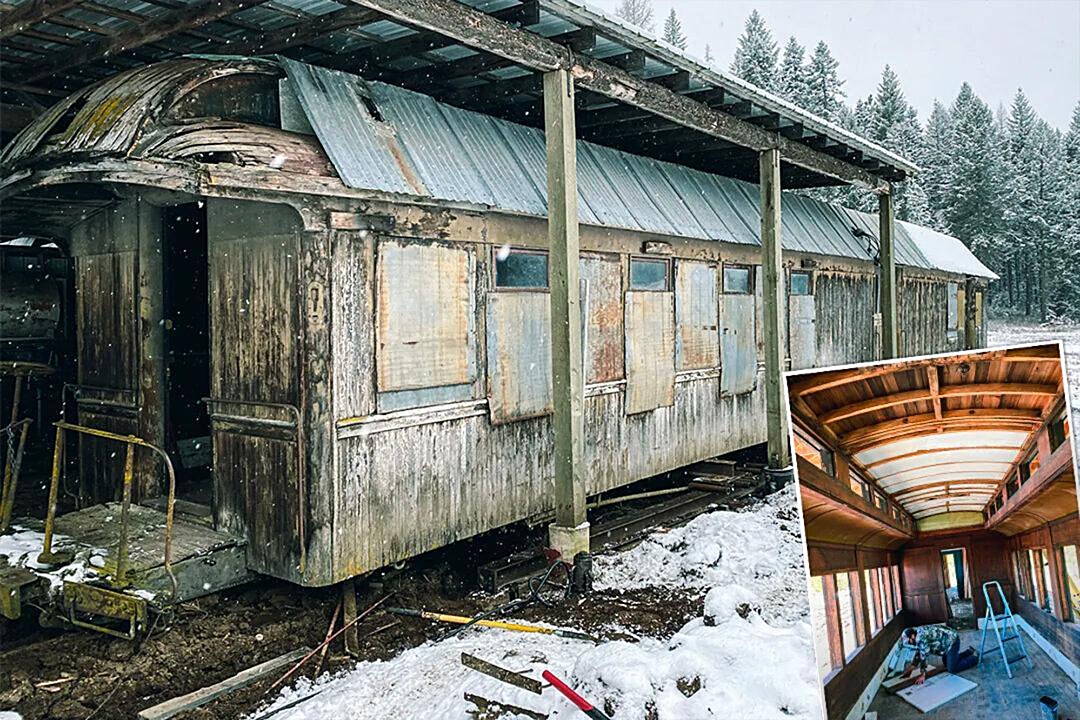In the winters of a few years ago, Edward French, a resident of Idaho, discovered a remarkable piece of history hidden beneath snow on his neighbor’s roof. It was a train car, infested with cats and almost unrecognizable, buried inside a barn. Intrigued by this find, the 55-year-old stumbled upon a photo of the train car, revealing that it was built in 1906. Eager to learn more, he started talking to locals about its history, discovering that the car, numbered 306, had been in active use in Washington and Montana until 1955. After its retirement, a farmer used it as a storage space for grain and hay, hauling it 10 miles to his field. Over the years, the 120-year-old relic became an obsolete part of the surrounding scenery.

Despite the dilapidated condition and unpleasant odor, Edward, who runs a construction company, saw beyond the decay and decided to purchase the neglected train car for just $2,000. His plan was to restore it to its former glory. This marked the beginning of an ambitious project that involved Edward and his eight sons. Together, they worked tirelessly from March through August of 2020, investing $147,000 and countless man-hours into the meticulous restoration process.


The restoration process began with stripping the wooden structure of the train car. After thorough sanding, the family was pleasantly surprised to find that the original structure was in relatively good condition. Excited and motivated by this discovery, Edward and his sons were determined to restore the train car to its former glory. With careful scraping, they even uncovered the original hand-painted lettering “306” that confirmed its identity as the same car from the old photo.



Throughout the restoration process, Isaac French, one of Edward’s sons and a hospitality consultant in Texas, reflected on the challenges they faced, including areas of severe rot that required careful patchwork. However, about 90 to 95 percent of the materials used in the restoration were original to the train car, maintaining its historical authenticity.



As Isaac and his siblings diligently restored every piece of the train car, they transformed it into a beautiful and historic guesthouse. To complement the original design from the 1900s, the French family used heritage paint colors, handcrafted light fixtures, and furniture from that era. Stepping inside the restored train car is like traveling back in time and experiencing the luxury of being a passenger in those early days of train travel.

Aside from the successful restoration, Isaac emphasized the impact this project had on their family dynamic. As homeschooled children who grew up working on the family farm, the restoration of the train car brought the siblings closer together. Isaac described it as a meaningful activity, especially during a time when much of the world was shut down. The completion of the project and welcoming their first guest marked a gratifying moment for the French family.

Isaac, who got married shortly after the restoration project, had the opportunity to spend a couple of nights with his wife in the restored train car. This moment brought a sense of fulfillment and closure to Isaac, who had invested so much effort into the project.

When asked about his favorite spot in the train car, Isaac mentioned the little lounge area. It provides a cozy atmosphere, perfect for reading or simply enjoying the breathtaking view. Perched atop a hill, the train car offers panoramic views of the farm fields and surrounding forests.


Visitors have been captivated by the unique experience offered by the restored train car. Their enthusiasm has inspired Isaac to create more one-of-a-kind experiences. Subsequently, he developed a micro-resort property with seven distinct cabins on a 5-acre land. The success of the restored train car project led Isaac to eventually sell the micro-resort property for a record-breaking price.
Isaac’s passion for creating unique experiences fueled the restoration project, and he expressed his satisfaction with the end result: “There’s nothing else like it.” The French family’s dedication and craftsmanship have revived a piece of history, allowing visitors to step back in time and appreciate the beauty of train travel from a bygone era.

